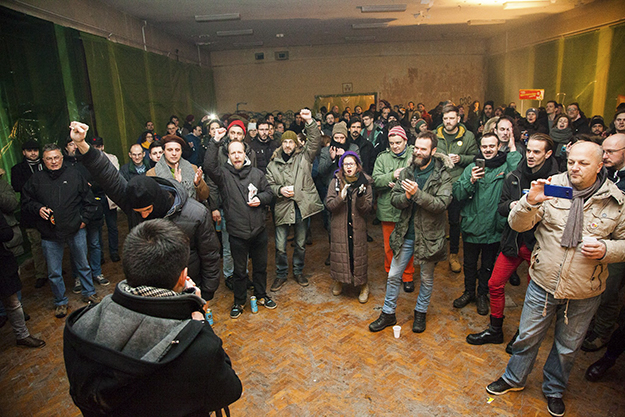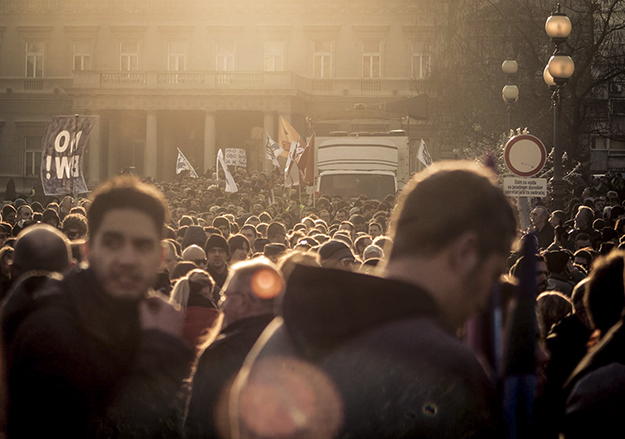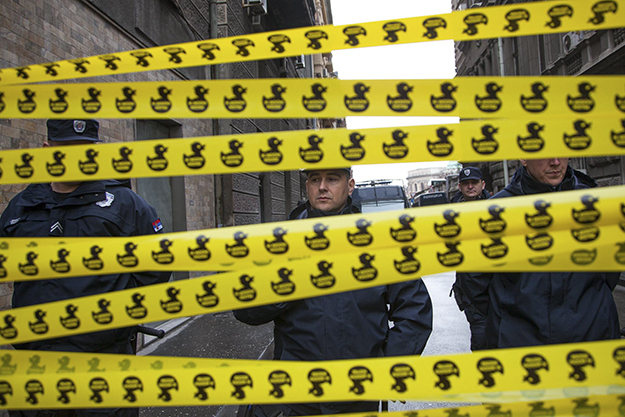As police patrols kept an eye on the people passing by between Belgrade’s Terazije Square and the National Assembly, a group of activists, supporters and journalists gathered in an underground space some 200 meters from the Assembly. It was the evening of Sunday, March 4, and they were waiting, mostly nervously, for the announcement of results from the Belgrade local elections that had taken place earlier that day.
These elections were the first time that representatives from the activists’ initiative Ne da(vi)mo Beograd (Don’t Let Belgrade D(r)own) had run for local office, after four years of active lobbying in the city. The capacious basement was tightly packed with people, tension and a sense of hope.
Ne da(vi)mo Beograd was established in 2014, when a citizens’ group decided to get in the way of the construction of the multi million “Belgrade Waterfront” redevelopment. Today, it is a political movement, which received the support of 30,000 Belgrade citizens at the ballot box.

Ne da(vi)mo Beograd entered elections for the first time in March, although failed to pass the 5 percent threshold required to secure representatives. Photo courtesy of Ne da(vi)mo Beograd.
As the night went on and the results came in, the tension and hope amongst members of the initiative was replaced with a sense of disappointment as it became clear that they had fallen short of the 5 percent threshold that would have secured them local representation.
But upon reflection, this soon turned to a sense of pride. For most people in the room, the local elections were their first experience in leading a campaign, and despite limited media space and modest financial means, collected from initiative members and supporting individuals and organizations, they still considered that their 3.5 percent of the vote share represented an important political breakthrough.
Fight for public interest
This initiative includes around 200 members of different profiles and interests. They say their goal is to fight “against the violence inflicted upon the public interest in favor of the private one” and “against the exclusion of citizens in making decisions regarding public funds.”
Everything started almost four years ago, in July 2014, when a group of citizens got involved in a public debate on the Draft Spatial Plan for regulation of the coastal part of the city of Belgrade, a document that would help to pave the way for the Belgrade Waterfront project.

The Ne da(vi)mo Beograd initiative started as a group of concerned citizens coming together during the planning stage of the flagship Belgrade Waterfront development in Serbia’s capital. Photo courtesy of Ne da(vi)mo Beograd.
Objections were subsequently sent to Belgrade’s City Administration, under the name Ne da(vi)mo Beograd; in total, activists say that around 250 citizens and experts worked to file thousands of objections to changes to both the General Plan for the city of Belgrade and the Draft Spatial Plan relating to the waterfront area — all suggestions were rejected.
Construction on the Sava embankment was ultimately given the go ahead through the National Assembly’s adoption of a lex specialis on April 9, 2015 (although in reality, work on the ground had already started the previous year). Two weeks later, a contract was signed between the Republic of Serbia and investors from the United Arab Emirates, said to be worth 3.5 billion euros.
When the 69-page contract (259 pages in the English version, which was the only one to include attachments) was published in September 2015, it emerged that the investor is only obliged to invest 150 million euros and an additional 150 million euros in loans, whereas the Republic of Serbia is required to secure additional loans and fully prepare the construction site.
In addition to the huge discrepancy in the investment amount compared to what had been promised, activists highlighted a series of objections, not least the leasing of 177 hectares of public land to a private company free of charge for an indefinite period of time.
In the meantime, Ne da(vi)mo Beograd had introduced the emblem that would quickly become the symbol of their resistance: A yellow duck. (In Serbian slang, ‘duck’ is a word for penis, while according to the activists in this case it symbolizes great fraud “which mustn’t remain unaddressed.”)

Activists and supporters of the initiative have taken to the streets of Belgrade in their thousands in recent years. Photo courtesy of Ne da(vi)mo Beograd.
The big duck — 2 meters high — first appeared on April 2, the day the lex specialis was due to be debated by lawmakers. With the idea of indicating that something was going wrong with democratic decision-making in Serbia, the protesters set the duck between two Serbian flags on masts in front of the Assembly. However, after the police intervened, it had to move to the nearby Nikola Pasic Square, where it remained for days.
Activists issued a press release saying that one duck had come in front of the National Assembly, while the other “entered the National Assembly in the form of a Draft Law,” and invited the elected deputies to oppose the proposal.
It was the first of many protest actions that have followed, with activists estimating that more than 40,000 people attended the largest protest in 2016. In Belgrade, for the first time in many years, an anti-fascist song was sung, as activists walked through the city to the sounds of ¡Ay Carmela! the anthem of Spanish republican troops from the time of the civil war. Ahead of the protests, people were invited via social media to participate en masse, and many of them responded positively.
Under the slogans “It won’t pass!” and “Whose city? Our city!” activists demanded the resignation of Belgrade’s mayor, Siniša Mali, and all those officials who they view as responsible for facilitating the construction of the Belgrade Waterfront development.
Since construction of the development got underway, the initiative has also filed several criminal complaints against those responsible for the construction work. They believe that their negligence has caused general danger due to damage inflicted upon the Sava embankment, after a 16 meter wide hole opened up at the construction site, where one of the embankments collapsed.
“Protests are only one aspect of all the things we have been doing for the past few years in order to stop the construction of the Belgrade Waterfront,” says Andrija Stojanović, one of the initiative’s activists.
Stojanović also points out that activists from the initiative haven’t focused their attention solely on Belgrade’s most prominent construction project, but have also gotten involved in other city projects where they believe there is wrongdoing. “We have analyzed the state of affairs in the field, and written objections, pointing to the reasons for which we think that the Belgrade Waterfront construction is harmful, in addition to [highlighting problems with] other urbanistic projects.”
Swelling support
Perhaps the biggest injection of energy into the Ne da(vi)mo Beograd initiative came in Spring 2016, following a now infamous series of events.
On the night of April 24-25 that year — local, regional and parliamentary election night — several buildings in the Savamala neighborhood that were in the way of the Belgrade Waterfront development were demolished. To this day, the public does not know who destroyed them; while police submitted an investigation report to the Public Prosecutor’s Office in June 2017, the Prosecutor has yet to respond.
What is known is that a group of masked people with demolition machinery destroyed buildings in Hercegovačka Street that had been identified for clearance as part of enlarging the Belgrade Waterfront construction site; local activists had previously helped to prevent their demolition by organizing several protests.
In the course of events, the access to Hercegovačka Street was blocked with trucks, several passersby were stopped and their phones were taken, security cameras from the surrounding buildings were removed and a guard at the site was tied up and his phone taken. He was later taken to hospital, where he passed away several days later. In the media speculation that followed, his death was regularly linked to the stress he suffered on the night of the demolitions, while the Ministry of Health was forced to deny claims that he had not received appropriate medical attention in hospital.
In an unrelated incident two months later, a vendor at a green market in the Vidikovac Quarter died next to his crates of mellons after the Communal Police asked for his ID. It was later clarified that the man had not had permission to be selling watermelons and that he had previously had several encounters with the Communal Police at the market.
But the incident added to a perception amongst some citizens that the modus operandi of Belgrade’s Communal Police is unnecessarily harsh, with several officers having been disciplined or suspended for overstepping their authority in recent years. As a response to what the activists saw as police brutality, the initiative members smashed 200 kilos of watermelons at the Belgrade Communal Police headquarters, inviting them to take responsibility for their treatment toward Belgrade citizens.

Activists say that their initiative grew quickly in 2016, with their biggest protest to date seeing 40,000 people taking to the streets. Photo courtesy of Ne da(vi)mo Beograd.
In the wake of these events, sympathizers of numerous opposition groups in Serbia joined the protests, including the Libek libertarian movement, a number of members and supporters of opposition parties and many people from the academic community, such as professor and activist from Belgrade, Srbijanka Turajlić, and Belgrade-based writer and professor from Sarajevo, Igor Štiks.
“Since the guard did not survive the night in Hercegovačka street, and when the vendor who got sick when he met the Communal Police at the market in Vidikovac died, the protest movement grew massively,” Stojanović says. “People reacted to the death of their citizens.”
With the initiative deciding to stand for public office in the most recent local Belgrade elections, support came from individuals and organizations from around Europe, including the pan-European supranational movement DiEM25. The founders of DiEM25 are the former minister in the Greek government and economy professor Yanis Varoufakis, and Croatian philosopher Srećko Horvat; some of the movement’s other members include British director Ken Loach, composer Jean-Michel Jarre, founder of Wikileaks Julian Assange, Slovenian philosopher Slavoj Žižek, Croatian philosopher Boris Buden, Canadian author and activist Naomi Klein, and sociologist Saskia Sassen.
Numerous other organizations from countries including Spain, Germany, France, Belgium and Poland have also offered their backing to the initiative, while a video message of support arrived from Zagreb, on behalf of the Zagreb je NAŠ movement.
Seeking systematic solutions
“Among themselves, our members are very different people, but they share the same values and feel personal responsibility as citizens of Belgrade,” says Milan Škobić, another activist from the initiative. “These are mostly people that manage to do something else besides earning for their sheer existence, or to make enough in order to donate some money to the common cashbox.”
They explain that the focus of action has shifted from dealing with individual cases, such as protesting against Belgrade Waterfront, the building of more skyscrapers in the New Belgrade district at the expense of green spaces and the forced eviction of vulnerable people from their home, to seeking systemic solutions to problems. The initiative has also mapped the so-called hotspots in Belgrade, that is, the places that they say have real and potential risk of sharing the fate of the Sava embankment.
“I joined the initiative as an interested citizen,” Stojanović says. “I was angry due to the fact that precious Belgrade space was handed over to somebody overnight, while citizens did not have a say in it. We went to public discussions, but there I saw it was a simulation of the process where citizens are allegedly having their voices heard, because all their objections were denied out of hand. It is then that I realized that it was the responsibility of all of us that realize we have been affected by these decisions to inform other citizens about it.”
Since the Ne da(vi)mo Beograd initiative has still largely dealt with the issue of public spaces to date, there were those who huffed at their candidacy in the local elections and described them as unprepared to solve city issues, with critics regularly pointing out that Belgrade’s elections were about something a lot wider than the Sava embankment or the park in the Novi Beograd blocks.
Stojanović says that the initiative is still searching for the best model to get politics back into the hands of the citizens. “We believe that we must explain to the people that politics is not only a concern of some politicians, but that it is their call whether there will be a new kindergarten or school in some block, or if they will be built in a nearby block due to some political decisions,” he says.
The price of activism
During their work, Ne da(vi)mo Beograd’s activists say they have faced numerous unpleasant situations, from online death threats, to physical assaults during protest actions. These allegations have been reported to the police, but to date no perpetrators have been prosecuted.
“We have filed 50 complaints for threats we received via the internet to the Department of High-Tech Crimes,” Stojanović says. “We filed 10 complaints for harassment on the street. A few days before the [March 2018] elections, we were informed that two or three cases had started to be processed.” The activists add that these cases were only processed after a protest they organized in front of the Public Prosecutor’s office, as a reminder that the complaints had not been processed since they were first filed in 2016.

Activists complain that their complaints to police about harassment have not been taken seriously, while a disproportionate effort has been made to pursue minor misdemeanor charges against them. Photo courtesy of Ne da(vi)mo Beograd.
On the other hand, charges for various forms of violation of public order and peace have been filed against several members of the initiative. Some have already been issued fines of between 100,000 and 150,000 RSD (850-1250 euros) for minor misdemeanors such as posting stickers that advertise the initiative and writing inscriptions on public walls and asphalt. Some of the misdemeanor charges filed against the initiative’s members are now obsolete due to the amount of time passing before the courts took decisions, others have been rejected, while others have outstanding hearings that are yet to take place.
“These are long-lasting processes,” Stojanović says. “For example, I have to go to court only in the second half of this year.”
Some activists say that charges relating to events where they were not personally identified by the police have been brought to their addresses, and question why the police seem to be spending so much of their time investigating relatively minor allegations against them, rather than the death threats they have received.
“Somehow, the police identified me without anybody asking to see my personal documents at the event with regard to the charge I received. They somehow established that it was me. I don’t think a lot about it,” Škobić says, adding that he sees no other way to respond to the threats and pressure than to live with it. “As long as we do not come to the point of receiving criminal charges, the situation is bearable. As long as nobody is threatening to lock us up for what we are doing, I don’t think it’s that tough to face all this.”
This sense stoicism is also reflected by fellow activist, Jelena Mijić, who says she is grateful that subtle pressure, threats and monitoring have so far not been more intense or extended to loved ones. “I was charged with writing letters on the sidewalk in front of the City Assembly, but at that event I was also not asked to show my ID,” she says. “The fact our families have not been affected yet is somewhat soothing. In the past I’ve doubted whether I have the emotional capacity to deal with such pressure, but as time passes, I’m more resistant to it and deal with it better.”
The activists are determined not to give in to such pressures and to continue lobbying for these causes through all legal tools available.
Even though short-term disappointment was present in the headquarters of the initiative, and a few tears were shed after the election results were published, activists rallied themselves and declared that a new struggle for the city was underway. The next local elections will take place in 2020.
“No matter that we didn’t succeed in getting a spot in the City Assembly in these elections, we will continue to be present through active civic participation,” activist Radomir Lazović says. “We will write recommendations, file complaints, and keep on doing everything that we can as citizens in order for the values we represent to win.”K
Photo courtesy of Ne da(vi)mo Beograd.






